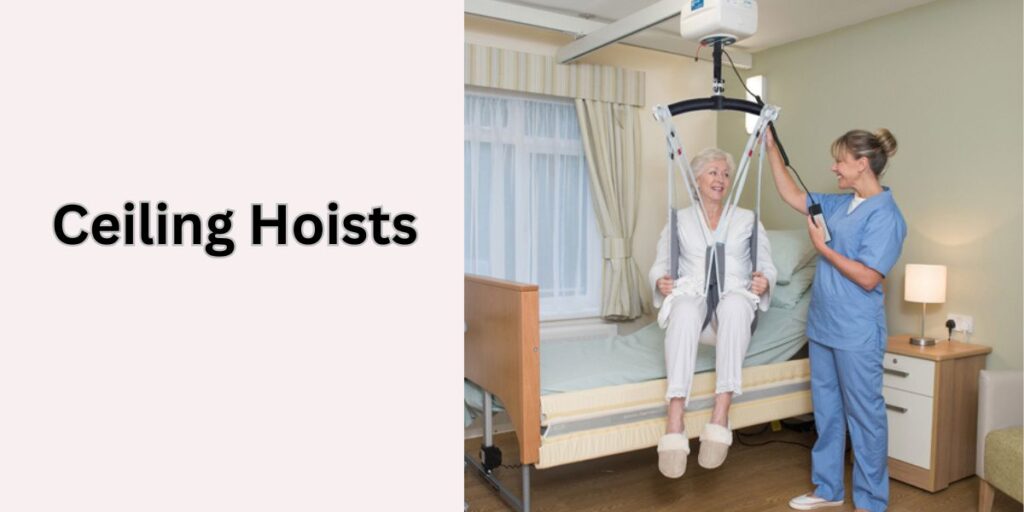When services are aimed at older individuals, such as in aged care, the main focus is safeguarding residents and enabling them to be self-sufficient. The ceiling hoist system is a modern development that has been used over the past few years.
These systems are designed to assist caregivers in moving residents safely and efficiently, enhancing mobility in facilities for older individuals. This blog will explore why ceiling hoists are essential for supporting older individuals regarding their independence and safety.
Enhanced Safety for Residents and Caregivers
Ceiling hoists ensure that disability participants who require lifting and care have a significantly decreased likelihood of sustaining an injury. Elderly individuals require physical assistance all the time, and handling them may result in accidents and related complications within the caregiver, such as back and other muscular injuries.
Their solution is ceiling hoists, which are mechanical devices used to help move people, reducing the workload for caregivers while simultaneously minimising falls among participants.
Promoting Independence Among Residents
Ceiling hoists enable elderly residents to be mobile without depending on the goodwill of other caregivers. This independence is essential to help them uphold their dignity and enhance their quality of life.
People can be moved from bed to chair or into the bathroom much more quickly and contribute more to their daily functioning.
An independence like this is essential because it gives older adults the value, faith, and confidence they need.
Versatility and Flexibility in Design
Ceiling hoists can be installed throughout a facility, providing flexibility in the methods and locations of transfers. This flexibility enables smooth transitions between rooms, allowing caregivers to assist participants effectively.
Facilities can tailor the installation of ceiling hoists to suit the specific needs of participants, whether in bedrooms, communal areas, or bathrooms.
Reduced Physical Strain on Caregivers
Ceiling hoists reduce the stress exerted on caregivers since they assist in implementing these hoists, and many caregivers can then be free to attend to other urgent tasks.
Less handling of the residents also means less force exertion, fewer injuries, and less work-related fatigue, increasing staff satisfaction and retention.
This is even more crucial in the aged care sector because it is a well-documented fact that there is always high turnover.
Improved Hygiene and Comfort for Residents
Ceiling hoists reduce the amount of physical work strain on the caregivers; hence, they can work more on offering quality care to the patients.
This way, the chance for the caregivers to feel the physical pressure decreases, job satisfaction rises, and resident turnover increases.
This is especially important in aged care services, where caregivers’ attrition rate is high.
Compliance with Health and Safety Regulations
Residential aged care services are legally bound to follow health and safety regulations. The employment of ceiling hoists complies with regulations by enhancing safe manual handling techniques.
Adopting these systems helps reduce accidents and ensure the overall safety of residents and staff. It is also a way of showing the facility’s dedication to quality service.
Cost-Effectiveness in the Long Run
Despite the relatively high initial costs of installing ceiling hoist systems, they generally demonstrate a long-term low-cost trend. Since the rate of accidents common within health institutions is normalised or minimised, there is a decrease in the costs incurred in terms of protection and workers’ compensation.
Further, efficient and effective caregiving makes it easy for the staff to organise their work, increasing productivity. Over time, these factors contribute to a more sustainable financial model for aged care facilities.
Encouragement of Social Interaction
Ceiling hoists result in easier transfers within the home so residents and other community members interact. Vehicle use rises when individuals can freely attend social events, enhancing their chances of participating in group activities and increasing opportunities for fellowships.
This social interaction is vital for the well-being of the people; hence, ceiling hoists are essential to encourage a lively community spirit.
Customisation for Individual Needs
Ceiling hoist systems can be customised to accommodate each resident’s unique needs. It can be noted that facilities can choose hoists with varying capacities, transfers, and construction to meet their client’s needs.
This degree of customisation guarantees that each resident receives the proper support tailored to their unique mobility needs. By meeting individual needs, facilities enhance the overall effectiveness of their care and support services.
Training and Support for Caregivers
Implementing ceiling hoists offers opportunities for comprehensive training and support for caregivers. Facilities can provide training on proper usage, boosting staff confidence and competence.
This enhances safety and improves caregivers’ skills and job satisfaction, leading to higher-quality care for residents and benefits for the facility overall.
Positive Impact on Resident Outcomes
Several studies have pointed out that ceiling hoists can significantly affect residents’ physical well-being, mood, and activity levels. These advantages improve quality of life, as individuals feel more connected and less reliant on caregivers. Additionally, these positive outcomes enhance the reputation and standards of the care facility.
Future-Proofing Aged Care Facilities
As the aged care sector evolves, innovative solutions like ceiling hoists are essential for supporting an ageing population. These systems promote independence and dignity for residents, positioning facilities as leaders in quality care. Investing in ceiling hoists attracts families and staff who appreciate a progressive approach to aged care.
Wrapping It Up
Ceiling hoists are modern tools for helping older people in aged care homes and making them feel safe and accessible regarding physical mobility. Therefore, such systems are critical in the overall role of reducing the physical pressures on the caregivers as well as increasing mobility.
To explore various options and necessary specifications for required ceiling hoists, consider visiting https://chshealthcare.com.au/product-category/ceiling-hoists/ to find suitable ones.
While the aged care sector is growing constantly, ceiling hoists will always play a crucial role in ensuring a pleasant environment for all disabled participants or aged ones.







